Uptake of in-vitro fertilization among couples attending fertility clinic in a tertiary health institution
Mabel Olubunmi Omobude, Olaolorunpo Olorunfemi, Fidelis Uchendu Okafor
1Department of Reproductive Health Nursing, Edo State College of Nursing Science, Benin City, Edo State, Nigeria
2Department of Medical Surgical Nursing, Faculty of Basic Medical Science, Federal University, Oye-Ekiti, Ekiti State, Nigeria
3Department of Nursing, University of Benin, Benin City, Nigeria
ABSTRACT
Objective: To identify factors that determine the uptake of in-vitro fertilization (IVF), and to determine the predicting effect of the identified factors on the uptake of IVF among couples attending fertility clinic at a tertiary health institution in Benin City, Nigeria.Methods: This study adopted a cross-sectional descriptive design. A self-structured questionnaire tested was validated and administered to 250 couples who attended fertility clinic. Data were collected from March 2021 to June 2021 and were analyzed using the Statistical Package for Social Science (SPSS) version 21. Data were presented and interpreted using descriptive statistics and inferential statistics such as Chi-square, univariate statistics and multivariate logistic regression analysis.
Results: Among 250 couples, 154 (61.6%) were willing to adopt IVF. The multivariate logistic regression analysis showed that catholic religion [odds ratio (OR) 0.21, 95% confident interval (CI)0.54-0.73], family income (OR 1.50, 95% CI 1.10-2.00) and age (OR 1.04, 95% CI 1.01-1.10) were the major factors that determined the uptake of IVF, with P-value of <0.001, 0.018 and 0.031,respectively.
Conclusions: The uptake of IVF could be sustained or improved on, if the government should improve on the cost of living for families, and religious leaders need to be encouraged to pass on the information about IVF to their members to be well guided about the possibilities of IVF.
KEYWORDS: Uptake of IVF; Couples’age; Family income;Catholic religion; Cost of living; Nigeria
Significance
In-vitro fertilization (IVF) has been widely accepted globally,but the adoption of these technologies is still fraught among couples in Nigeria. This study shows that catholic religion,family income and age constituted a major reason for not supporting IVF and concluded that the government needs to improve on the cost of living and religious leaders, especially catholic priest should be encouraged to pass appropriate information about IVF to their members so that couples would be well guided about the possibilities of IVF.
1. Introduction
Every couple is happy when they can reproduce and have their own babies[1]. Worldwide, infertility occurs in about one in six couples, and it is more in low income countries than in the high income ones[2]. In Africa, overall rate of infertility is about 30%[3-5].Infertility is a condition that affects the reproductive system of any individual[6], and is defined as condition where the couple is unable to conceive after one year or more of regular unprotected sexual intercourse[7,8]. Infertility occurs in over 50% of cases that are seen in gynecology clinics, and 72.4 million people worldwide suffer from the disease, which is recognized as one of the major global gynecological and social problems according to the World Health Organization[9,10]. In Nigeria, the rate of infertility is 30%[4,11], and it is described as reproductive health problem and major reason for gynecological consultations[12]. In most low income countries, where parent is seen as a social obligation to have babies and infertility is unacceptable and is stigmatized due to the way the society valued children[13,14]. Infertile women suffer social consequences more than infertile men, but generally infertility among couples causes major challenges in Africa[15].Assisted reproductive technologies (ART) are presently being established for couples who would like to have babies[16,17]. For most infertile couples, in-vitro fertilization (IVF) or intracytoplasmic sperm injection (ICSI) could be their last opportunity to have children; some of the infertile couples opted out and are also denied further fertility treatment for several reasons. The International Committee Monitoring Assisted Reproductive Technology reported in 2011 that about 3 million children were delivered worldwide by IVF[18,19]. A study from Nigeria estimated that 30% to 40% of patients with infertility as a result of tubal blockage will require ART treatment[4,20]. Different types of infertility treatments have been widely accepted in the society[21]. But adoption of these technologies is still fraught among couples in Nigeria. Therefore, the aim of this study was to investigate the uptake of IVF among couples attending fertility clinic at a tertiary health institution in Benin City,Nigeria. Specifically, this study aims to: 1) identify the factors that may determine the uptake of IVF among couples attending fertility clinic; 2) to examine whether the identified variables can predict the uptake of IVF among couples attending fertility at a tertiary health institution clinic.
2. Materials and methods
2.1. Study design and setting
A cross-sectional descriptive design was adopted to enable the researchers to determine the uptake of IVF among couples attending fertility clinic at a tertiary health institution, Benin City Edo State.A self-structured questionnaire that was tested and validated was administered to 250 couples who attended the fertility clinic. This study was carried out in Human Reproduction Research Program Obstetrics and Gynecological Department of University of Benin Teaching Hospital, Benin City, Nigeria.
2.2. Data collection and measurement
Data collection took place from March 2021 to June 2021. The instruments used for this study was a self-structured questionnaire that was tested and validated and administered to 250 couples who attended the fertility clinic. The questionnaire was administered by the researchers to the couples attending fertility clinic, in order to elicit first-hand information from respondents. The questionnaire was made up of the following sections: 1) demographic data; 2)awareness of IVF practices and uptake of IVF. The awareness of IVF practice scale consisted 4 items with maximum and minimum percentage score (yes) of 100 and 0, respectively. Percentage score of 80-100 indicated high level of awareness, 50-79 indicated moderate level of awareness and < 50 indicated low level of awareness. The uptake of IVF scale included 4 items with maximum and minimum percentage score of 100 and 0, respectively. Percentage score of 80-100 indicated high level of uptake, 50-79 indicated moderate level of uptake and < 50 indicated low level of uptake.
Demographic data were a part of the questionnaire that was designed to obtain personal information from the respondents. This was used to assess information about age, sex, occupation, level of education, monthly family income, family type, ethnicity, duration of infertility and type of infertility. The responses from here were cross tabulated with the uptake of IVF, to find the association between the dependent and independent variables.
Awareness of IVF practices and uptake of IVF was part of the questionnaire that helps to determine the awareness of IVF practice among respondents. It was close-ended questionnaire that accessed the awareness of vital information about IVF and their source of information, while the last part accessed the uptake of IVF among respondents.
The instrument was assessed and scrutinized by an expert to verify the content validity ensuring the items measured what was ought to measure. In order to ensure the reliability of the instrument, the split-half method was used as an indicator of the instrument stability and consistency. This was done by administering the instrument to 10 couples attending fertility clinic in Central Hospital, Benin city. The questionnaire was prepared with the input of an expert in the field and a statistician to enhance validity of the instrument.Cronbach alpha was used to test the reliability of the instrument, and the reliability coefficient in this study was 0.87; this showed a high level of reliability of the instrument. The researchers with the help of other research assistance administered the questionnaire to the participants. The researchers were present during the filling in of the questionnaire for correction as well as clarity and achieved 100% return of the instrument.
2.3. Sample size
Accidental sampling method was used to select sample size of 250 couples. The sample size was calculated according to Slovin’s formula[22].

n=sample size, population size (N)=400 couples and the mergin of error (e)=0.05, with confidence level of 95%. The inclusion criteria were couples who were willing to participate in the study and couples with any comorbidity that could limit him or her from participating actively in the study were excluded.
2.4. Statistical analysis
Data obtained were coded and analyzed using the Statistical Package for Social Science (SPSS) version 21.00 statistical software(IBM corp. released 2012. IBM SPSS statistics for widows, version 21.0 Armonk, NY: IBM Corp). Statistical techniques used in the study were: percentage and simple frequency distribution table for descriptive analysis, while Chi-square, Fisher’s exact test, and multivariate logistic regression on implicating factors identified in review literatures to determine the extent of prediction of independent variables on the uptake of IVF (dependent variables)respectively, based on the objective of the study, at P<0.05 level of significance.
2.5. Ethical considerations
Before the study, permission was obtained from the University of Benin Teaching Hospital Ethical and Research Committee with protocol number: ADM/E22/A/VOL.V11/14570, dated 26 January 2018. A written consent was attached to the questionnaire to seek participants’ consent. A detailed explanation of what the research was all about was also given to the respondent. Participation was voluntary, and confidentiality was ensured. No form of harm or injuries was caused to respondents bearing in mind the Belmont report of principles. The respondents were not exposed to any forms of harm especially psychological, as some of these couples were already psychologically distressed because of the way the society views infertility. Respondents were assured that the information that was obtained would not be used against them in any way. Their privacy was also maintained throughout the study, as no name or form of identification was obtained during the data collection.
3. Results
3.1. Socio-demographic and infertility characteristics of respondents
The respondents’ mean age was (32.2±5.2) years. Over two third of the respondents (210; 84.0%) were less than 35 years of age,while 35 (16.0%) of the respondents were greater than or equal to 35 years of age. All of the respondents (100.0%) were Christians, 221(88.4%) and 29 (11.6%) being Pentecostal and Catholic Christians,respectively. As for the occupation, 115 (46.0%) respondents were civil servants, 72 (28.8%) were self-employed, 31 (12.4%), 16(6.4%) and 16 (6.4%) were traders, farmers and unemployment,respectively. Majority of the couples [187 (74.8%)] had tertiary level of education, 63 (25.2%) had secondary level of education. The highest proportion of the couples [162 (64.8%)] had monthly income< 365 dollars, while the remaining 88 (35.2%) had monthly income≥ 366 dollars. As for family type, most of the couples [148 (59.2%)]were from a monogamous family setting, while 102 (40.8%) came from a polygamous family setting. Regarding ethnicity, over a half of the respondents [134 (53.6%)] were Binis, 31 (12.4%) were Igbo,29 (11.6%) were Yoruba, 24 (9.6%) were Esan, 16 (6.4%) were Urhobos and 16 (6.4%) were Afemais.
More than half of the couples’ infertility had lasted for < 7 years(57.2%), and 107 (42.8%) of the respondents’ infertility had lasted for ≥ 7 years. Over half of the respondents [133 (53.2%)]had secondary infertility, 117 (46.8%) had primary infertility. The infertility reason for over a third of the respondents (85; 34.0%) was unknown, 51 (20.4%) was blocked tube, 45 (18.0%) was fibroid,38 (15.2%) was infections, and 31 (12.4%) was low sperm count.Moreover, 93.6% respondents were married couples and only 6.4% of the participants were divorced couples (Table 1).
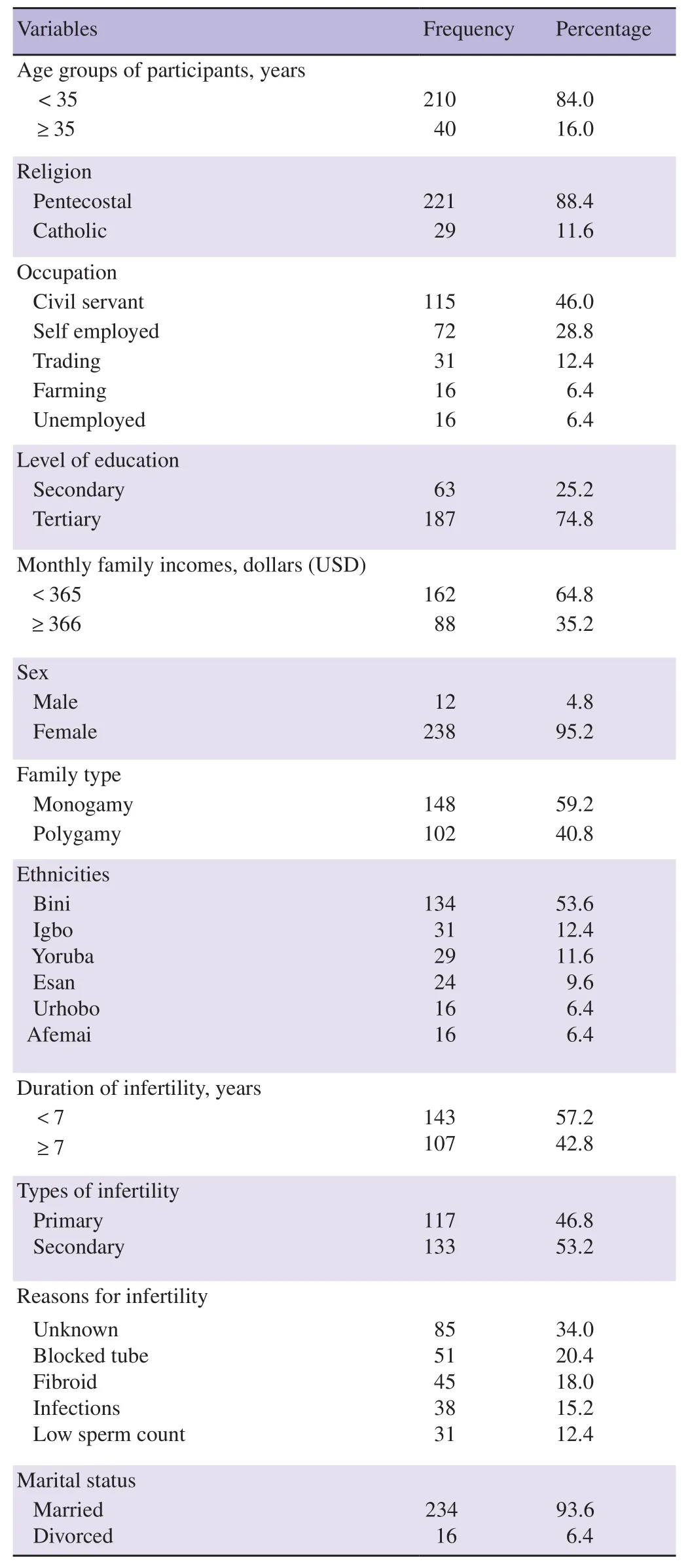
Table 1. Socio-demographic and infertility characteristics of respondents(n=250).
3.2. Awareness of IVF practice among respondents
Table 2 shows that all of the couples [(250; 100.0%)] were aware of the practice of IVF, with 92 (36.8%) having TV, radio jingles as their source of information, while 79 (31.6%), 71 (28.4%), and 8(3.2%) of the respondents got the IVF information from internet,family member and Church, respectively. Most of the respondents[180 (72.0%)] were aware that IVF treatment could fail, while 70(28.0%) were not aware that treatment could fail. More than half of the respondents [126 (50.4%)] were aware that IVF could be used for treatment of male infertility, while 124 (49.6%) were not aware that IVF could be used in treatment of male infertility.
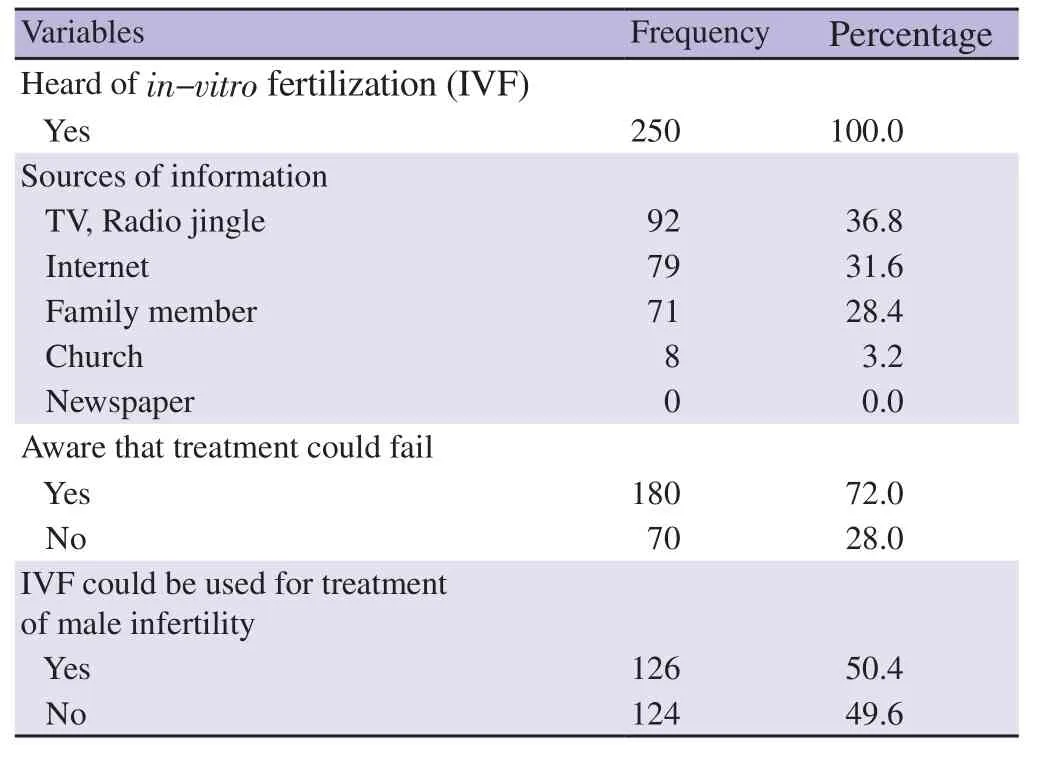
Table 2. Awareness of IVF practice among respondents (n=250).
3.3. Willingness of adopting IVF
Table 3 shows that 154 (61.6%) of the couples were willing to adopt IVF, while 96 (38.4%) couples were not willing to adopt IVF and their reasons were based on the following reasons: high cost of treatment [51 (51/96; 53.1%)], religious reason [14 (14/96; 14.6%)]while the remaining [31 (31/96; 32.3%)] have no reason for rejecting the procedure.
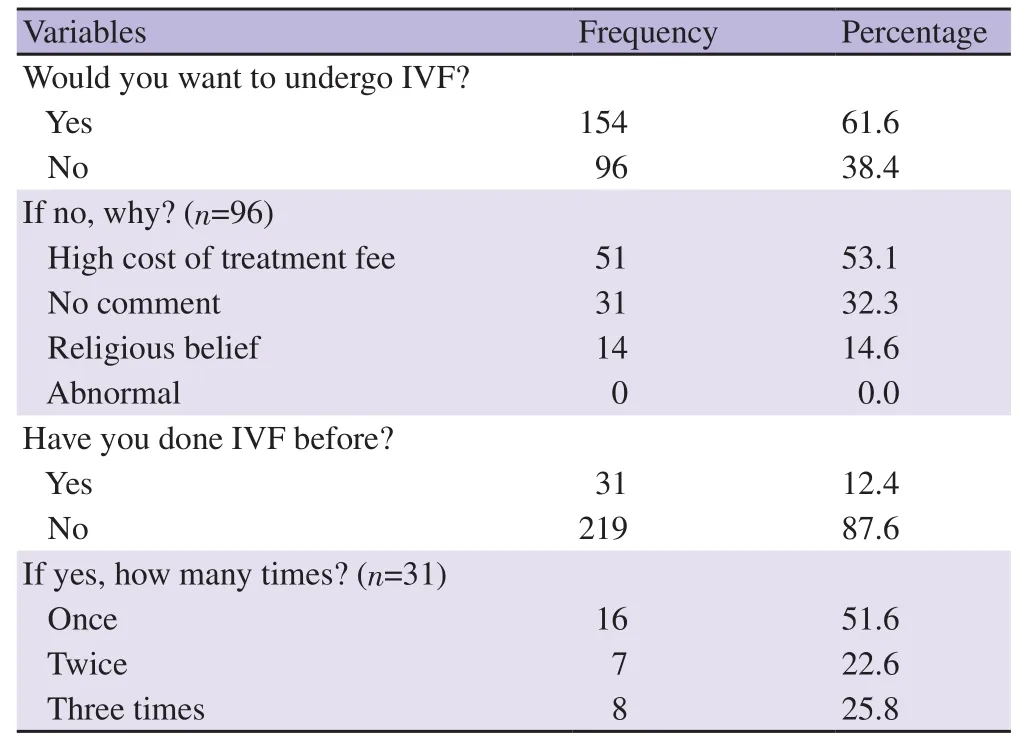
Table 3. Uptake of IVF among respondents (n=250).
3.4. Univariate analysis of socio-demographic characteristics and IVF uptake
As shown in Table 4, the univariate analysis showed a significant association between willingness to adopting IVF and factors including age, family type, level of education, duration of infertility,type of infertility, family income and religion with P-value of less than 0.05 or 0.01.

Table 4. Univariate analysis on the association between socio-demographic characteristics and willingness to adopting IVF (n=250).
3.5. Multivariate regression analysis of association between socio-demographic characteristics and IVF uptake
The multivariate logistic regression analysis (Table 5) shows that among the different ages, only the couples with ≥ 35 ages were found to be significantly associated with the uptake of IVF, which means old women are willing to take IVF with an odds ratio (OR) of 1.04 (95% CI 1.01-1.10; P=0.031). Moreover, concerning religion,negative association was found between Catholic and the uptake of IVF, with an OR of 0.21 (95% CI 0.54-0.73; P<0.001), while as for monthly family income, couples with income higher or equal to 366 USD were found to be significantly associated with the couple’s willingness for IVF uptake, with an OR of 1.50 (95% CI 1.10-2.00;P=0.018).
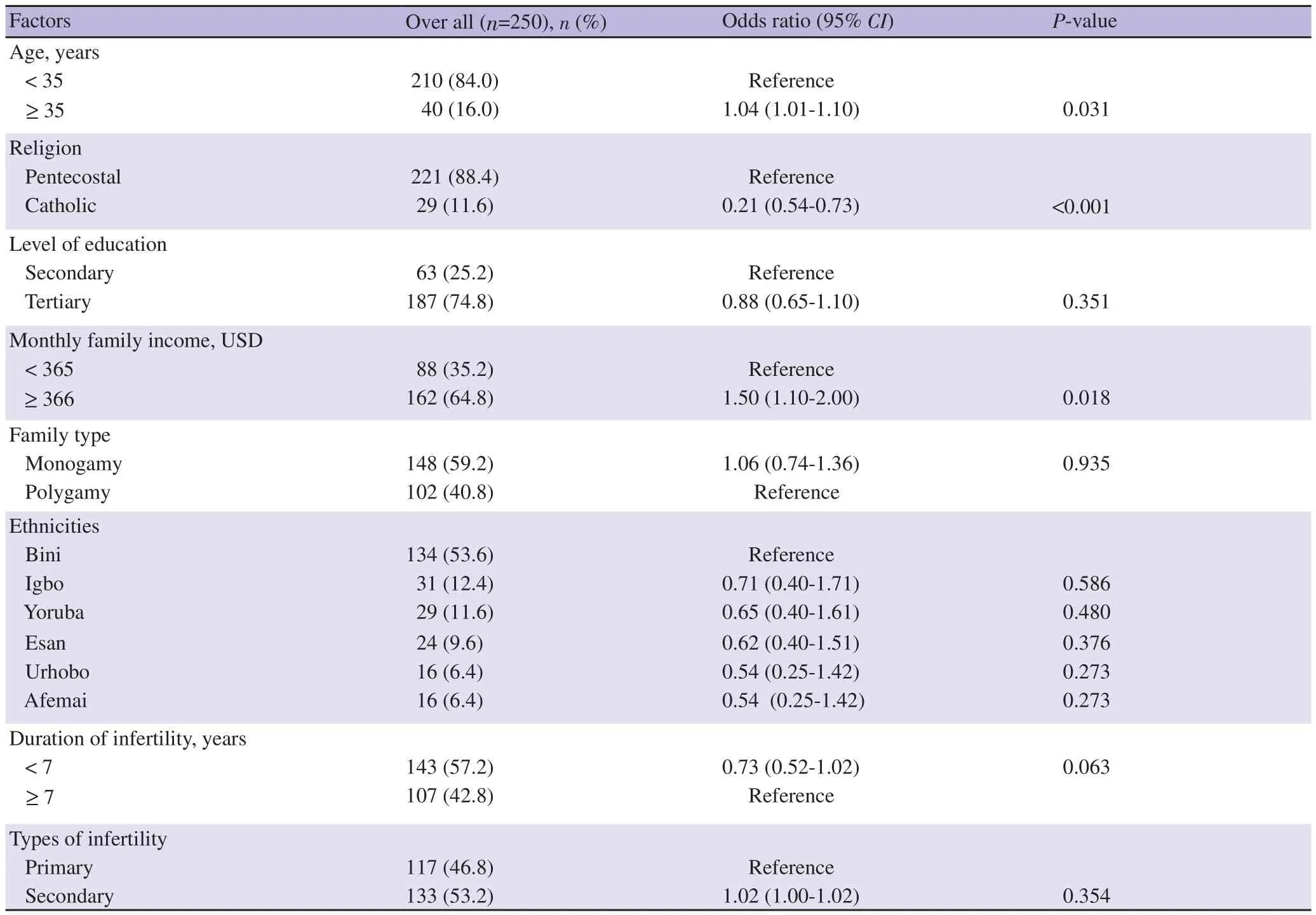
Table 5. Multivariate logistic regression analysis showing impact of socio-demographic characteristics of couples on IVF uptake.
4. Discussion
4.1. Socio-demographic characteristics influence on the uptake of IVF
This study reveals that the mean age of respondents is (32.2±5.2)years. This is similar to the findings of the study conducted by Okwelogu et al[23] where the mean age of the respondents was 30 years; this is younger than that reported in Department of Obstetrics and Gynecology, University of Ilorin Teaching Hospital from January 2012 to December 2015 [(36.1±6.6) years][24]. The discrepancy in the ages reported could be due to late age of marriage as a result of education and career pursuit among female urban dwellers. Late age of marriage may result in low fertility among women. In this study, most of the respondents had tertiary level of education. This is similar to the study carried out by Adenike et al in 2014 on prevalence of infertility and acceptability of assisted reproductive technology in women attending gynecology clinic at tertiary institution in southern west of Nigeria where majority of the women have high educational level and secondary level of education[25]. This is also in contrast to the findings of the 2006 Census where more female respondents had secondary level of education[26]. Tertiary level of education is considerably high and educational differences might be due to the fact that this study was carried out in urban areas where there were more educated people than in the rural areas. Educated mothers made informed choices on their health needs.
All of the respondents were Christians, with 88.4% and 11.6% being Catholics and Pentecostal Christians. This is in contrast to the findings of 2013 Nigeria Demographic and Household Survey which showed that more than half of women were Muslims[27]. This may be a result of location of the study which is the southern part of Nigeria where the religion is predominantly Christianity. In this study most of the respondents (93.6%) are married couples. This is in agreement with a study carried out by Lee et al in Australia where more of the married couples agreed to the use of ART[28]. This could probably be as a result of stigmatization and social pressure that parenthood are highly valued to the extent that childbearing is usually considered the most important reason while marriage is in existence, and this could also be because there is more social support for married couples to attend fertility clinics.
This study shows that less than averages of the participants are civil servant (46.0%). This is in agreement with a study on latestlate fertility decline and resurgence of late parenthood across the low-fertility countries and found that couples in higher professional and managerial occupations are more likely to postpone first births,they compress the time to motherhood, having additional children significantly faster[29], and this may be responsible for the poor attitude toward IVF uptake in this study.
This study also shows that 64.8% of the couples have < 365 USD as montly income, which is far less than the cost of IVF treatment(3 943.24 USD) in Nigeria, and this is a major reason why most couples could not access IVF in the country. This corroborated with a study on household income and medical help-seeking for fertility problems among a representative population in Japan and found that improvements in the financial accessibility of infertility care would have promoted ease of access to IVF[30].
In more than half of the respondents (57.2%), the duration of infertility had lasted for < 7 years. This finding is similar to the findings of a study conducted in China which revealed that more than half of the respondents’ infertility had lasted more than 5 years. This may be as a result of the poor health seeking behavior which could further reduce the chances of the woman of getting pregnant and secondary infertility was more common than primary infertility[31]. This is in tandem with the findings of the study conducted by Okwelogu et al[23] where more of the respondents had secondary infertility. This is because women with primary infertility are more eager to seek medical help.
4.2. Willingness of adopting IVF
Almost two-third of the respondents (61.6%) opted for IVF, with half of the respondents who would not want to undergo IVF giving the high cost of treatment as the reason it was rejected, while 18.8% declined IVF because of religious belief. This is in tandem with the findings of a study done in south-west Nigeria to determine the prevalence of infertility and acceptability of assisted reproductive technology among women attending gynecology clinic at tertiary institution, which revealed that 73.5% of respondents who were aware of IVF would opt for it[25]. This could be due to the increased level of awareness among respondents and may also be due to the fact that people are now looking beyond certain superstitious and religious beliefs about ART. Majority of the respondents between 43-47 years of age (6/8; 75.0%) opted for IVF uptake. This is similar to the findings of a study done by the Fertility Centre in London from 1984 to 1989, which showed that older couples were more willing to opt for IVF. This may be due to the fact that older couples are more likely to have suffered from infertility longer and so may be more desperate than younger couples to get a child.
4.3. Education level or infertility type influence on uptake of IVF
In the study, there is a significant difference in the education level of the participants between the IVF willingness and non-willingness groups. This finding is in line with the result of the study carried out to assess the awareness and acceptability of assisted reproductive technology among infertile women, which revealed that more educated women were more willing to undergo IVF procedure[7,32].This may have stemmed from the fact that educated respondents are more likely to be more informed about IVF and hence are invariably going to be more favourably disposed to its practice/uptake.
Majority of the respondents (78.6%) with primary infertility agreed to undergo IVF. This is in contrast to the findings of a study conducted by Okwelogu et al in 2012, where majority of respondents had secondary infertility and would also opt for IVF procedure if offered[23]. This could be due to the fact that since they have never had any child before and thus may be more open to trying newer measures to tackle infertility.
4.4. Religion and the uptake of IVF
Only about one-fourth of the respondents (24.1%) who are Catholic Christians agreed to undergo IVF. This is similar to the findings of the study done by Adenike et al[33] which showed religious belief constituted a major reason for not supporting ART. This could be due to the fact that the Roman Catholic Church does not accept assisted reproduction and even frowns at any form of ART, like IVF, artificial insemination, and surrogacy[34]. The Catholic Church believes that IVF is never acceptable because it removes conception from the marital act and because it treats a baby as a product to be manipulated, violating the child’s integrity as a human being with an immortal soul from the moment of conception.
4.5. Conclusions
This study sought to investigate the uptake of IVF among couples attending fertility clinic at a tertiary health institution in Benin City.The study also investigated whether socio economic status influenced the uptakes of IVF. Relevant conceptual literature, empirical studies and theoretical framework were reviewed. Descriptive survey design was adopted for this study. A questionnaire titled “Uptake of in vitro fertilization (IVF) among couples attending fertility clinic”was designed to elicit information from the respondents. The data collected were subjected to descriptive and inferential statistical analyses. The factors that determined the uptake of IVF were mostly Catholic religion, family income, and age of couples.
From this study, the following implications arise for necessary development. Government and the managers of IVF centers should prepare fertility education program for married couples, so that more of them would be encouraged to attend clinic. Additional efforts need to be put in place in order to educate couples and religious leaders on the benefits and potentials available in IVF uptake.
In this study, the following limitations were applicable. First, this research was directed only on a limited populace. Secondly, the level of patient’s honesty in response to the questionnaire may be considered a limitation, because of the fact that most couples have a belief that information on fertility is personal; therefore, they may complete the instrument on the basis of preconceived biases.
In conclusion, the study was designed to investigate the level of uptake of IVF among couples attending fertility clinic at a tertiary health institution in Benin City. The findings showed that the uptake of IVF among couples is determined by religion, family income,and age of the couples. On the basis of the findings of this study and the conclusion drawn, the following conclusions were made: most of the respondents were aware of IVF technique and majority of the respondents had the information about IVF from media, but the uptake is still very low. We, therefore, recommend that the religious leaders should be enlightened and encouraged to pass on positive information as regards IVF to their members, so that they in turn would be well guided about the possibilities of IVF.
Conflict of interest statement
The authors declare that there is no conflict of interest.
Authors’ contributions
Mabel Olubunmi Omobude, Olaolorunpo Olorunfemi, and Fidelis Uchendu Okafor conceived and designed the paper, involved in data collection, performed the statistical analysis, interpretation of data,and presentation of results and review of the manuscript.
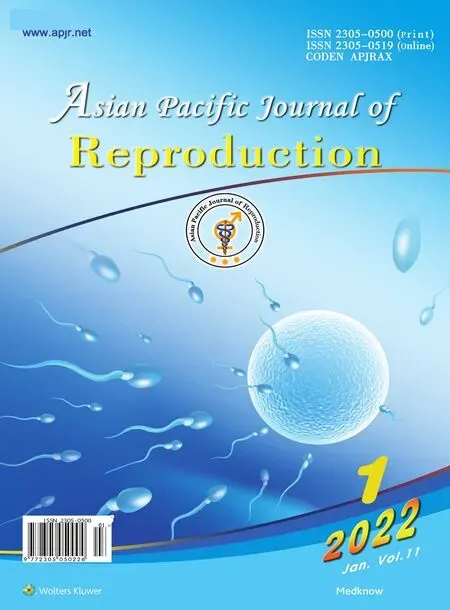 Asian Pacific Journal of Reproduction2022年1期
Asian Pacific Journal of Reproduction2022年1期
- Asian Pacific Journal of Reproduction的其它文章
- Successful live birth after intracytoplasmic sperm injection using testicular sperm in non-mosaic Klinefelter syndrome
- Effects of enzymatic and non-enzymatic antioxidants in diluents on cryopreserved bull epididymal sperm
- Taurine in semen extender modulates post–thaw semen quality, sperm kinematics and oxidative stress status in mithun (Bos frontalis) spermatozoa
- Blepharis persica increases testosterone biosynthesis by modulating StAR and 3 β-HSD expression in rat testicular tissues
- Recurrent ovarian endometrioma after conservative surgery: A retrospective study
- An implementation study of barriers to universal cervical length screening for preterm birth prevention at tertiary hospitals in Thailand: Healthcare managers’ perspectives
